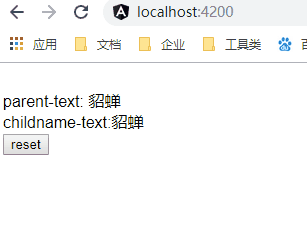组件间的 双向绑定
child.component.ts
...
@Component({
selector: 'app-child',
template: `
childname-text:{{childName}}<br/>
<button (click)=reset()>reset</button>`
})
export class ChildComponent{
@Input() childName:string = '';
@Output() childNameChange = new EventEmitter<string>();
reset(person:string):void{
this.childName = '王二麻子';
this.childNameChange.emit(this.childName);
}
}
/*
注意:EventEmitter的命名格式:xxxChange
xxx为双向绑定的哪个变量名,本例子中是childName,所以EventEmitter为childNameChange
*/parent.component.ts
...
@Component({
selector: 'app-parent',
template: `
<div>parent-text: {{parentName}}</div>
<app-child [(childName)]='parentName'></app-child>`
})
export class ParentComponent{
parentName:string = '貂蝉';
}双向绑定语法实际上是属性绑定和事件绑定的语法糖。 Angular 将 parent.component.ts 里面<app-child>的绑定分解成这样:
// <app-child [(childName)]='parentName'></app-child> 等价于下面的代码
<app-child [childName]='parentName' (childNameChange)='parentName=$event'></app-child>运行结果:

